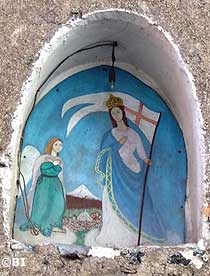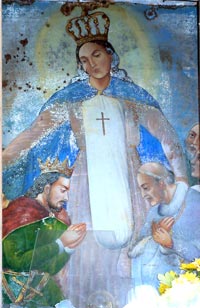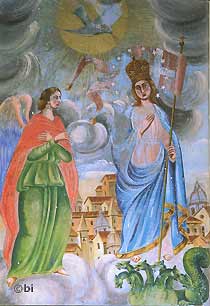The inner center
The votive Aedicule "A Cunnicella"
 In this page we wish to illustrate a particular religious aspect, characteristic of many little streets in the centre of town (common also in many other Sicilian towns) and typical of the religious tradition of the people: the votive Aedicule (“a cunnicella”). In this page we wish to illustrate a particular religious aspect, characteristic of many little streets in the centre of town (common also in many other Sicilian towns) and typical of the religious tradition of the people: the votive Aedicule (“a cunnicella”). We have looked for them going through every alley, flight of steps, tortuous, small streets of Bronte; can be seen without difficulty at every corner and crossroads. They are almost a consistent part of the urban structure in the historic centre of town.
Small architectural compositions attached to the houses, embedded in the external walls or in any street wall, tiny little temples built to protect a sacred image, a small statue or an icon. Rarely are located in the centre of streets, the preferred location is, nearly always, on the external wall of a house, few meters from the ground; adorned, well lit and normally containing a simple shelf. They are turned to the public space, to the street. From ancient times, as even now, continue to transmit the certainty of their protection. Nothing exceptional from an artistic point of view, very few can be defined art works. Some however show remarkable good taste and originality and many of them, especially in the centre, date from very ancient ages. All of them represent the deep religious sense and ancient devotion that link up Bronte’s people to their patron Our Lady Annunciate, to whom they address their prayers during the worst moments of their history, especially the ones related to Etna eruptions. She is in fact the recurring theme of the sacred representation.
 Every one of them hands down a story of its own, a tradition or an historic testimony. Every citizen of Bronte retains a clear memory of something linked to an event, a sensation or devotion. Every one of them hands down a story of its own, a tradition or an historic testimony. Every citizen of Bronte retains a clear memory of something linked to an event, a sensation or devotion. Some of them are linked even to a precise historic happening like the aedicule placed in the SS.Cristo area to remind us of a terrible lava eruption that miraculously stopped at the edge of the town in front of Our Lady’s statue. The genesis of the Aedicule realization is to be found in the existential need of the ancient peasant community.
It was a simple choice and a fairly cheap way to conway a message of faith, devotion and obedience usually with a painting or a picture, and, sometime, a small cross or a little statue.
In Bronte’s historic centre the Aedicules are truly everywhere.
Put as a protection to the house and the families grouped around it, was used for their cult. They represented the altar of the neighbourhood, of all the people living in adjacent streets.
Clearly the function of the small Aedicule, in the past, had, beyond the religious meaning, an aggregating value for the inhabitants of the houses nearby. During religious festivities at the Aedicule, adorned with flowers (and also fruit; at Christmas, mandarins among brambles) the families of the quarter (la ruga) used to be reunited and pray together. Modern life, with its new idols, other types of protection or security and the convulsive progress of time have obscured forever these traditions and their meanings. Especially in the older zones of town, now progressively neglected, some aedicules show their age, many have lost completely their decorations and design. They are votive niches, square, rectangular or arch vaulted, embedded in the wall thickness of the house or on the face of the wall with small pillars or columns and the sacred image set inside, with a covering and, nearly always, closed with pretty gratings or a simple wooden frame, protected by glass.  Micro-architectural structures, all different to one another, strangely shaped, simple or in baroque or classic style, poor or rich of ornaments, built with lava stone, sandstone or marble (rarely valuable). Micro-architectural structures, all different to one another, strangely shaped, simple or in baroque or classic style, poor or rich of ornaments, built with lava stone, sandstone or marble (rarely valuable).
Some of them (among the most ancient) modest and plain, but lovely in the colour and design still visible, others well made, rich of ornaments and well taken care of every particular, with colours, drawings and figures, vaguely naďf and a little lamp always lit. Nearly always have very simple and essential shapes, typically popular, rather poor in their materials, colours and decorations, with a small shelf for the votive offerings. The upkeep and the maintenance of the aedicule is carried out first by the initial founder and then by groups of neighbours related to him. The sacred image, generally, represents the Virgin Annunciate, Bronte’s patron, always different in her making, often portrayed beside the town, holding in her hand a flag attached to a long pole with which kills
a dragon. The explanation is well known as it is related to a legendary episode following the blady clash between soldiers and the people of Bronte during the riots of 1820.
With this page we wanted to give a small contribution to knowledge,
collecting images of some religious shrines in the streets of Bronte, with
the hope that this small heritage will not disappear with the passing of
time, as has already happened for some of a certain historical value that we
can now only admire in photographs. (Nino Liuzzo) |